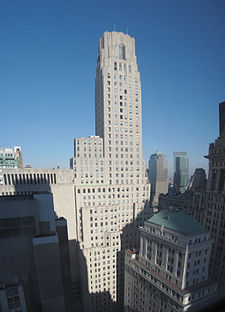
Back ون وول ستريت Arabic 1 Уол Стрийт Bulgarian 1 Wall Street German 1 Wall Street Spanish 1 Wall Street Estonian One Wall Street Basque وان وال استریت Persian 1 Wall Street French One Wall Street Italian 1 ウォール・ストリート Japanese
| 1 Wall Street | |
|---|---|
 Seen from the east in 2010 | |
 | |
| General information | |
| Type | Mixed use (residential and commercial) |
| Architectural style | Art Deco |
| Location | Manhattan, New York |
| Country | United States |
| Coordinates | 40°42′26″N 74°00′42″W / 40.70722°N 74.01167°W |
| Construction started | 1929 (original building) 1963 (annex) |
| Completed | 1931 (original building) 1965 (annex) |
| Opening | March 24, 1931 |
| Renovated | 2018–2023 |
| Owner | Macklowe Properties |
| Height | |
| Roof | 654 ft (199 m) |
| Top floor | 52[a] |
| Technical details | |
| Floor count | 50 |
| Floor area | 1,165,645 sq ft (108,292.0 m2) |
| Lifts/elevators | 41 |
| Design and construction | |
| Architect(s) | Ralph Walker |
| Developer | Irving Trust |
| Main contractor | Marc Eidlitz |
| References | |
| [1][2] | |
| Designated | March 13, 2001[3] |
| Reference no. | 2029[3] |
| Designated entity | Original building: exterior |
| Designated | June 25, 2024[4] |
| Reference no. | 2679[4] |
| Designated entity | Red Room: interior |
| Part of | Wall Street Historic District |
| Reference no. | 07000063[5] |
|
Preview warning: Page using Template:Infobox designation list with unknown parameter "designation3date" | |
1 Wall Street (also known as the Irving Trust Company Building, the Bank of New York Building, and the BNY Mellon Building) is a 654-foot-tall (199 m) Art Deco skyscraper in the Financial District of Lower Manhattan, New York City. The building, which occupies a full city block, consists of two sections. The original 50-story building was designed by Ralph Thomas Walker of the firm Voorhees, Gmelin and Walker and constructed between 1929 and 1931 for Irving Trust, an early-20th-century American bank. A 28-story annex to the south (later expanded to 36 stories) was designed by the successor firm Voorhees, Walker, Smith, Smith & Haines and built between 1963 and 1965.
The limestone facade consists of slight inwardly-curved bays with fluting to resemble curtains. On the lower stories are narrow windows and elaborate entrances. The massing of 1 Wall Street incorporates numerous small setbacks, and there are chamfers at the corners of the original building. The top of the original building consists of a freestanding tower with fluted windowless bays. The facade of the annex is crafted in a style reminiscent of the original structure. The original building has an ornate lobby, known as the Red Room, with colored mosaics. The 10th through 45th floors were originally rented to tenants, while the other floors contained offices, lounges, and other spaces for Irving Trust. After 1 Wall Street was converted to a residential building, the upper stories were divided into 566 condominium apartments.
At the time of its construction, 1 Wall Street occupied what was one of the most valuable plots in the city. The building replaced three previous structures, including the Manhattan Life Insurance Building, which was once the world's tallest building. After Irving Trust was acquired by the Bank of New York (BNY) in 1988, 1 Wall Street served as the global headquarters of BNY and its successor BNY Mellon through 2015. After the developer Harry Macklowe purchased the building, he renovated it from 2018 to 2023, converting the interior to residential units with some commercial space.
The building is one of New York City's Art Deco landmarks, although architectural critics initially ignored it in favor of such buildings as the Empire State Building and the Chrysler Building. The exterior of the building's original section was designated as a city landmark in 2001, and the Red Room was similarly designated in 2024. In addition, the structure is a contributing property to the Wall Street Historic District, a National Register of Historic Places district created in 2007.
Cite error: There are <ref group=lower-alpha> tags or {{efn}} templates on this page, but the references will not show without a {{reflist|group=lower-alpha}} template or {{notelist}} template (see the help page).
- ^ Cite error: The named reference
CTBUHwas invoked but never defined (see the help page). - ^ Cite error: The named reference
Emporiswas invoked but never defined (see the help page). - ^ a b Kurshan 2001, p. 1.
- ^ a b Buckley 2024, p. 1.
- ^ a b Cite error: The named reference
nris_2007was invoked but never defined (see the help page).